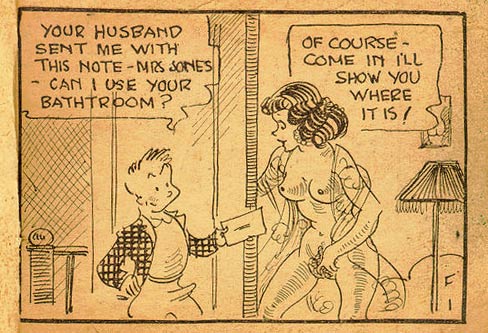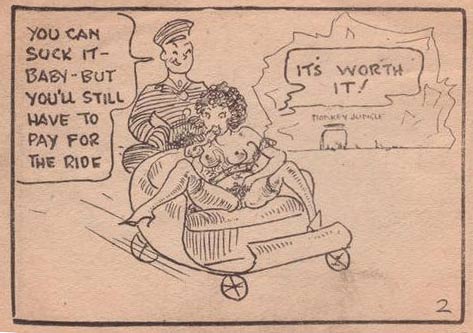Early 'Bazooka Joe' strip, 1954.
Wesley Morse was a productive American comic artist and illustrator. During the 1920s, he made various illustrations and comics starring flapper and chorus girls. He and Doc Rankin are one of the few previously anonymous creators of the Tijuana Bibles genre - pornographic comics starring pop culture characters - whom have been posthumously identified. Nevertheless, the majority of his artwork was done as a ghost artist, making it difficult to track down huge parts of his bibliography. The general public of today may recognize him best as an advertising comic artist. He created 'Bazooka Joe' (1954) - the mascot of Topps' chewing gum brand Bazooka - as well as the Copa Girl which is still the logo of the New York nightclub Copacabana. As one of the more obscure and reclusive comic artists, Morse has nevertheless gained more posthumous interest since the 1990s, with even a biography being published as recently as 2015.
Early life and career
Wesley Cherry Morse was born in 1897 in Chicago. He served in France during World War I. In the early stages of his career, he contributed cartoons and illustrations to magazines like Life, Judge, Collier's, The New Yorker, Shadowland, Snappy Stories and Film Fun. As a comic artist, Morse drew 'Switchboard Sally' (1925) with H.C. Witwer, 'Kitty of the Chorus' (1925), 'May and June' (1927) and 'Beau Gus' (1933) with Bud Wiley. He also assisted Victor E. Pazmiño on his newspaper comic 'Frolicky Fables' (1926) and is generally assumed to have been the ghost artist on Cliff Sterrett's 'Polly and Her Pals' in 1925, when Sterrett was unavailable for a few months.
Morse's artwork during the 1920s was a reflection of the roaring decade. It mostly centered around flapper girls, chorus girls and young men and women having fun in night clubs while listening to jazz and big band music. Some of his illustrations were part of the most famous musical revue of the period, namely Florenz Ziegfeld's 'Ziegfeld Follies'. Morse also enjoyed this lifestyle. He frequently visited local nightclubs and restaurants in New York City. Some were speakeasies - where one could drink alcohol illegally during the era of Prohibition. Morse had several celebrities among his friends, including columnist Walter Minchell, boxer Barney Ross, cartoonist Chic Young and Hollywood actors George Raft and William Demarest. He even dated Hollywood actresses like Ruby Keeler (best known for '42nd Street' [1933]) and Barbara Stanwyck (best known for 'Laura' [1944]).
'Today I am a Man! '(eight-page Tijuana Bible by Wesley Morse, spoofing Percy Crosby's Skippy.
Tijuana Bibles
Morse's enjoyment of the seedier - and illegal - side of life might explain why he predominantly worked anonymous. In the late 1930s, he drew several pornographic comics, the so-called "eight-pagers" or "Tijuana Bibles". One of his series was set at the 1939 World's Fair and are presumed to have been sold at the fair in question. As a result, they are one of the few Tijuana Bibles historians are able to accurately date.
Work in the 1930s and 1940s.
In the 1930s and 1940s, Morse was also active for the advertising group Blackstone and made illustrations, wall murals, illustrated menus and souvenirs for various night clubs and restaurants in Manhattan, including the Latin Quarter and Copacabana. In 1943, he designed the Copa girl for the Copacabana club. During World War II, he also drew various unsigned gag cartoons for joke books published by Larch.
'She Saw the World's Fair - and how!' (Tijuana Bible eight-pager by Wesley Morse), 1939.
Bazooka Joe
To mainstream audiences, Morse is most recognizable as the creator of 'Bazooka Joe'. In 1947, the company Topps launched its chewing gum brand Bazooka. Inside each gum wrapper was a little two-panel comic strip starring a character named 'Bazooka, the Atom Bubble Boy'. Each storyline had the little boy blow huge bubble gum bubbles to defeat criminals, rescue people and solve problems in general. In 1954 ,Topps organized a contest to find a new name for the character. To make it a bit easier for the young contestants they already suggested six possible names: 'Fly-Boy', 'Birdie', 'Bazookio', 'Sky-King', 'Rocket-Bot' and 'Blowhard' (this last name might have caused some unfortunate innuendo in later, less innocent times). A reader eventually came up with 'Bazooka Joe'. Topps' creative advisor Woody Gelman asked Wesley Morse to redesign the character. Morse gave him an eyepatch and a blue baseball cap. Just like his predecessor, Bazooka Joe is an expert in blowing bubbles with problem-solving abilities.
Bazooka Joe received some friends, also designed by Morse. Jane is his steady girlfriend. Orville (later Pesty) wears a sombrero, Hungry Herman has an enormous appetite and Mort's sweater spans so tight around his body that it covers his mouth and stretches his neck. Other recurring characters are the tough street kid Toughie, the music fan Metaldude and the dog Walkie Talkie. While some cartoons featured Bazooka doing something heroic, several others were more gag-based. The 'Bazooka Joe' comics were guaranteed a long lifespan and ran uninterrupted from 1954 until 2012. Morse drew them until his death in 1963, yet new editions kept appearing posthumously for years since he had prepared so many of them while still alive. Between 1967 and 1990, Jay Lynch wrote several episodes. Of all chewing gum advertising characters, 'Bazooka Joe' became the most iconic, even surpassing the much older 'Pud' of Dubble Bubble, drawn by Ray Thompson.
Death and legacy
Wesley Morse passed away in 1963. In 1996, the book 'Tijuana Bibles: Art and Wit in America's Forbidden Funnies' came out, with an introduction by Art Spiegelman. Spiegelman claimed he had recognized the style of Morse in several of these Tijuana Bibles. Since the Tijuana Bibles were such important predecessors to the underground comix movement and so little was known about the artists in question, the book instantly sparked more interest in the mysterious and mostly unearthed career of Morse. One man who discovered him through this book was Kirk Taylor, whose great aunt was Ziegfeld Follies dancer Avonne Taylor, with whom Morse once had a relationship. As it so happened, Kirk still owned several drawings Morse made for her and which had never been seen by the public before. Through underground comix artist Jay Lynch, Kirk got in contact with Talley Morse, Wesley's son.
Bazooka Joe inspired the name of Adam Ant's first rock band in the 1970s, as well as a 1980 song by T.C. Matic and a 1986 song by Big Black. In Raw issue #1 (July 1989), Robert Sikoryak drew a parody of 'Bazooka Joe' titled 'Inferno Joe', which spoofed Dante Alighieri's narrative poem 'La Divina Commedia' at the same time.
Books about Woody Gelman
Talley Morse operates the very informative website, www.wesleymorse.com, about his father. In 2015, Kirk Taylor and Nancy Morse - wife of Talley Morse - published the extensive and highly recommended biography 'The Life and Art of Wesley Morse' (2015).









